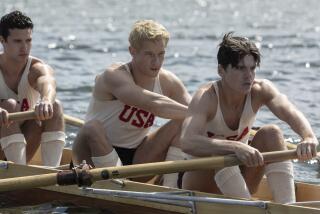Documenting a Marathoner’s Great China Run
- Share via
Veteran American marathoner Stan Cottrell was running from one end of the world’s most populous nation to the other, but Mickey Grant--the fellow who was directing “China Run,” the documentary being made of Cottrell’s trek--wanted him to just act naturally and be himself.
“He (Grant) kept telling me to imagine my kids watching the film, and thinking about how real the ‘me’ up there on the screen would seem to them after it was over,” recalled Cottrell, 44, in his gutbucket Kentucky drawl. “So I guess I was just following instructions--right up to getting sick and fainting a couple of times. The camera was right there all the time.”
Cottrell--averaging 40 miles a day in his running shoes, for 53 days, in spite of small broken bones in his ankle and foot--also happened to be the executive producer of “China Run,” and had hired Grant for the sizable task of filming his 1985 mega-marathon across China, from Beijing in the north to Canton in the south.
“China Run” opened two weeks ago at the Westside Pavilion. It has done good business for a documentary film, according to the Landmark Theaters chain, which has extended the film’s run through Thursday.
Right up front, Grant--a veteran line producer, editor and director of TV and film documentaries--insisted on the creative control to call his own shots. Over breakfast recently, He and Cottrell agreed that the marathoner didn’t hesitate a minute.
“I was going to have a few other things to think about,” he said with a smile. “And besides, Mickey seemed to be so fired up about doing the picture that I couldn’t say no.” Cottrell also allowed that Grant’s fluent Mandarin Chinese--which made him the only one able to communicate with the Chinese film crew--might have influenced his decision a tad.
“I really did insist on making the camera an independent observer of the run,” Grant said. “Now, Stan had a lot of money and commitments riding on this thing--he’d been trying to get it off the ground for six years--and he could have told me to buzz off, or dictated how the thing was going to go. But I wanted badly to tell his story--I mean, it’s an incredible story, when you think about it--and I insisted on doing it by the ‘Sinatra method’: my way.”
So Cottrell--who said he made the transition from business suit and tie to warm-up suits largely because he “never said I can’t do that”--submitted himself to the unswerving attention of a film crew for almost two months of bone-grinding effort in the midst of a strange country, language and culture.
“I wasn’t exactly threatened by the camera’s constant attention,” Cottrell said slowly. “But there were a number of times I wanted to be by myself, not the subject of scrutiny. But if the film was going to be made the way Mickey had in mind, I had to just let it happen. So after a while I just stopped paying attention to it.”
Wielding such an active camera to record such a willing subject caused Grant to reconsider his position more than once along the 2,108-mile route.
“It was no picnic to make a film under those conditions, I can say that,” said Grant, who has made films about Viet Cong tunnels, camel races in Egypt and American professional wrestling. “From time to time I wondered if I was indeed recording events as they happened, or if I was causing them to happen by being so much in Stan’s face. But the various impossibilities of working a film in China made me forget all about philosophy and think instead about making sure the film loader put the stock in the right way.”
Indeed, philosophical and practical differences between Grant and his Chinese cinematographer and crew caused some minor problems during the course of the shoot. “The camera operators didn’t understand I wanted to get everything down on film, including Stan’s frailties,” Grant recalled. “When he collapsed one time (Cottrell caught a bad flu about two-thirds of the way through the run, and lost 17 pounds of body weight before he recovered fully), nobody was filming it. They all stood around looking the other way because they thought it mean-spirited and ‘incorrect’ to film a man being ill.”
But capturing the culture-clash between the born-poor, can-do Cottrell and his very shy, painfully polite Chinese hosts and interview subjects was one of Grant’s (and Cottrell’s) highest priorities in filming “China Run.”
“We went to a lot of places Americans hadn’t been for 30 years,” Cottrell said. “The main reason I ran through China was to show the Chinese people what a typical American thought like, sounded like, ate like. The occasional hassles, confusions and roadblocks we encountered made the final result all the more worthwhile.”
Dead ahead for Cottrell and Grant: more cultural mixes, this time with the Vietnamese. The runner and the director plan to go from Hanoi to Ho Chi Minh City during February and make another film of that odyssey, this time under the banner of their joint production company.
“I’m calling it Miracle Productions,” Cottrell said, “ ‘cause it’s a miracle we got through China all in one piece and the film actually got made. And it’ll be another miracle when we go through Vietnam, and make a film out of that. It just goes to show you: You can make miracles commonplace if you just believe they’re going to happen.”
More to Read
Only good movies
Get the Indie Focus newsletter, Mark Olsen's weekly guide to the world of cinema.
You may occasionally receive promotional content from the Los Angeles Times.









